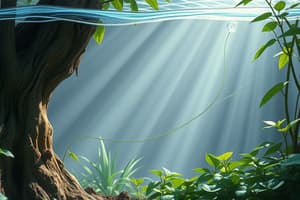Podcast
Questions and Answers
What is the primary source of energy in most ecosystems?
What is the primary source of energy in most ecosystems?
- Nutrients from the soil
- The sun (correct)
- The wind
- Animal movement
All food chains begin with heterotrophs.
All food chains begin with heterotrophs.
False (B)
What are autotrophs?
What are autotrophs?
Organisms that produce their own food using sunlight or chemical energy.
The arrows in a food chain show the movement of __________ through an ecosystem.
The arrows in a food chain show the movement of __________ through an ecosystem.
Match each level of ecology to its definition:
Match each level of ecology to its definition:
Which of the following correctly describes heterotrophs?
Which of the following correctly describes heterotrophs?
Energy flows through an ecosystem in a cyclical manner.
Energy flows through an ecosystem in a cyclical manner.
What percentage of energy is typically passed on to the next trophic level in a food chain?
What percentage of energy is typically passed on to the next trophic level in a food chain?
A __________ is an area characterized by a specific climate and is a part of the biosphere.
A __________ is an area characterized by a specific climate and is a part of the biosphere.
Which term refers to the sum of all living things in a specific area?
Which term refers to the sum of all living things in a specific area?
Flashcards
Biotic factors
Biotic factors
All the living things in an ecosystem.
Abiotic factors
Abiotic factors
All the non-living things in an ecosystem.
Ecology
Ecology
The study of the interactions between organisms and their environment.
Biosphere
Biosphere
Signup and view all the flashcards
Population
Population
Signup and view all the flashcards
Community
Community
Signup and view all the flashcards
Ecosystem
Ecosystem
Signup and view all the flashcards
Autotrophs
Autotrophs
Signup and view all the flashcards
Heterotrophs
Heterotrophs
Signup and view all the flashcards
Food chain
Food chain
Signup and view all the flashcards
Study Notes
Unit 1 - Energy and Matter Flow
- Energy in most ecosystems originates from the sun.
- Abiotic factors are non-living components (e.g., air, water, sunlight).
- Biotic factors are living components (e.g., plants, animals).
- Organisms: single living things.
- Population: all organisms of the same species in an area.
- Community: all living things in an area.
- Ecosystem: all biotic and abiotic factors in an area.
- Biome: major ecosystems characterized by climate & plants.
- Biosphere: all parts of Earth where life exists.
- Autotrophs (producers) create their own food.
- Heterotrophs (consumers) obtain energy by consuming other organisms.
- Food chains show the flow of energy, start with producers.
- Arrows in food chains show energy transfer.
- Only 10% energy transferred to the next trophic level.
Levels of Ecology
- Organism—a single living thing.
- Population—all organisms of the same species in an area.
- Community—all living things in an area.
- Ecosystem—biotic and abiotic (nonliving) factors in an area.
- Biome—a large geographic area with similar climate.
- Biosphere—all the parts of Earth that support life.
Food Chains
- Food chains show the transfer of energy from one organism to another.
- The arrows point from the source of energy to the receiver.
- Food chains always begin with a producer (autotroph).
- Energy is lost at each trophic level, and only ~10% is transferred to the next level.
- Producers (plants)—create their own food.
- Primary consumers—consume producers.
- Secondary consumers—consume primary consumers.
- Tertiary consumers—consume secondary consumers.
Food Webs
- Food webs are more complex than food chains, showing multiple interconnected food chains.
Difference between autotrophs and heterotrophs
- Autotrophs make their own food (e.g., plants).
- Heterotrophs must consume other organisms for energy (e.g., animals).
Water Cycle
- Accumulation: Water collection.
- Condensation: Water vapor cools and forms clouds.
- Evaporation: Liquid water changing to water vapor.
- Precipitation: Water falling from the sky (rain, snow, etc.).
- Elements cycling in the ecosystem are Carbon, Oxygen, Nitrogen.
Photosynthesis
- Sunlight + Carbon Dioxide + Water --> Sugar + Oxygen
- Photosynthesis converts solar energy into chemical energy (sugar).
Cellular Respiration
- Sugar + Oxygen --> Carbon Dioxide + Water + Energy
- Cellular respiration releases stored energy from sugar to fuel life processes.
Biodiversity
- Related to the variety of life in an area.
- High biodiversity indicated by high number of species present..
- Symbiosis: relationship between 2 species (mutualism, commensalism, parasitism).
Invasive Species
- Invasive species are not native to an area, and often disrupt natural ecosystems.
Unit 2 Biomes and Adaptations
- Biomes are large geographic areas with specific climate and organisms.
- Various biomes including Tundra, Taiga, Temperate Deciduous Forest, Grassland, Desert, Tropical Rainforest. Each with unique temperature and animal/plant life.
Unit 3: Biodiversity
- Symbiosis: A close relationship between two different species.
Unit 4: Populations
- Population density: Number of individuals in a specific area
- Carrying capacity: Maximum population size a particular environment can support.
- Limiting factors: factors that restrict population growth.
- Density dependent factors: depend upon population density, i.e., competition.
- Exponential growth: uncontrolled growth of a population.
Studying That Suits You
Use AI to generate personalized quizzes and flashcards to suit your learning preferences.




